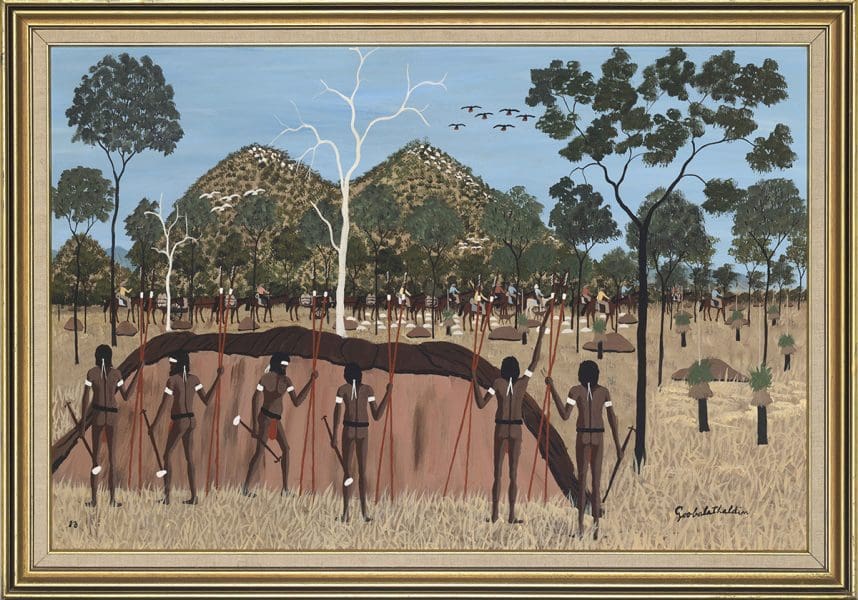
Making Space at the Table
NAP Contemporary’s group show, The Elephant Table, platforms six artists and voices—creating chaos, connection and conversation.




Aboriginal artist Goobalathaldin Dick Roughsey was born under a cluster of pandanus palms on Mornington Island in the early 1920s. He came from a strong line of Lardil ancestors deeply connected to the islands of far north Queensland and their waterways. Goobalathaldin’s mother, Kuthakin, was from the Eastern Lardil people and his father was called Kiwarbija, a name that denotes the rough and roiling seas.
Throughout his life, Goobalathaldin painted what he knew – from his traditional Lardil culture and childhood interaction with religious missionaries, to the explorations of Cape York he undertook with Percy Trezise (a pilot, painter writer and explorer, among other things).
A joint project between Cairns Art Gallery and Queensland Art Gallery | Gallery of Modern Art (QAGOMA), Stories of this Land is the first retrospective exhibition of Goobalathaldin’s work. Curated by Teho Ropeyarn and Bruce Johnson Mclean, the exhibition contains over 70 pieces including books, historical and ceremonial objects, paintings on bark, and oils on canvas, each item shedding new light on Goobalathaldin’s experiences as an artist and storyteller. “Goobalathaldin’s life and career were extraordinary and have gone largely unrecognised,” says co-curator Bruce Johnson McLean. “This exhibition is a crucial chance for us to celebrate his work and legacy.”

As a child Goobalathaldin lived traditionally with his family on Lardil country before he was taken to a nearby Presbyterian mission to attend school. There Goobalathaldin was given the name Dick Roughsey, a westernised interpretation of his paternal affiliation with the sea. Following his education at the mission school, Goobalathaldin worked as a stockman, deckhand and craftsman, yet always maintained a connection to his Lardil culture. Goobalathaldin regularly spent time in the bush, hunting and fishing with traditional methods, crafting ceremonial objects and creating bark paintings that illustrated everyday life on Mornington Island.
The goanna, stingray and dugong were regular fixtures in Goobalathaldin’s bark paintings as were depictions of water lily harvests and the knobbly bulbs of pandanus fruit. “In Stories of the Land, Goobalathaldin’s landscape paintings feature north Queensland ancestral narratives,” McLean says. “Also included are his painted scenes of life pre- and post-European contact from his community on Mornington Island.” This blended experience of both Aboriginal and Eurocentric culture gave Goobalathaldin the opportunity to observe the unfolding intersection of two disparate cultures. It was a subject he revisited often in his paintings. Looking at these works from the contemporary perspective presented in Stories of this Land reveals the importance of Goobalathaldin’s work as a contemporary documentation of history from an Aboriginal point of view.
In addition to Mornington Island, Cape York Peninsula was a consistent presence in Goobalathaldin’s life and it was there he forged a friendship with Trezise, who had a keen interest in Aboriginal rock art. Trezise taught Goobalathaldin how to use oil and acrylic paints and soon after Goobalathaldin adopted a way of working that was more akin to Western landscape painting. This allowed him to alternate between traditional bark paintings like The Emu and the Turkey (1971) and multicoloured landscape scenes.
One of the most significant of these sites was Quinkan Country near the small Queensland town of Laura. Containing prehistoric depictions of powerful Aboriginal Dreamtime figures, Quinkan Country and the rock art Goobalathaldin and Trezise found there became the inspiration for their next collaboration. Throughout the 1970s and 1980s, Goobalathaldin and Trezise wrote and illustrated a series of children’s books. Filled with quirky humour and a unique brand of bush horror, many original drafts from The Giant Devil Dingo (1973), The Rainbow Serpent (1975) and The Quinkins (1978) are included in Stories of this Land.
At a time when the government-led action of forcibly removing Aboriginal children from their families was still occurring, Goobalathaldin’s work played an important part in generating more understanding of Aboriginal culture. “I think Goobalathaldin’s works are really one of the reasons why attitudes to Aboriginal culture changed,” says McLean. “His story books aimed at young audiences introduced a generation of young Australians to Indigenous narratives of this land.” A trailblazer who went on to become the inaugural Chair of the Australia Council’s Aboriginal Arts Board, publish an autobiography and gain an OBE, Goobalathaldin remained an unfailing champion for Aboriginal people. As McLean suggests, “Stories of this Land is really a chance to celebrate Goobalathaldin’s achievements and to also recognise the depth and diversity of his work as an artist and cultural hero.”
Stories of this Land
Queensland Art Gallery and Gallery of Modern Art (QAGOMA)
30 March—18 August
This article was originally published in the March/April 2019 print edition of Art Guide Australia.